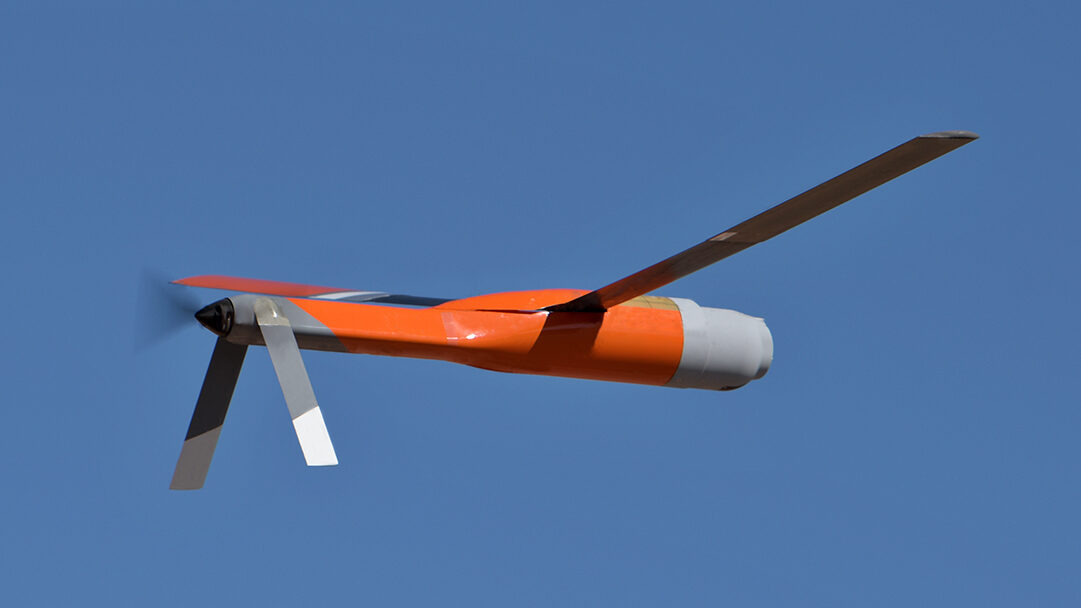
An Area-I Air-Launched, Tube-Integrated, Unmanned System, or ALTIUS, sails through the skies at Yuma Proving Ground, Ariz., March 4. (Photo by Jose Mejia-Betancourth/CCDC AvMC Technology Development Directorate)
WASHINGTON: In the middle of the Utah desert, the US Army plans to test the efficacy of swarms of mini-drones that the service hopes will provide a ISR, targeting and battle damage assessments.
But as the Army tinkers with the emerging technology at the ongoing EDGE 22 experiment at Dugway Proving Ground, service leaders already know one thing: With the swarm of drones comes a flock of challenges.
“There’s just waveforms and how they’re transmitted through the sky, and what’s in the sky at the time, and what kind of things the Lord has thrown into the sky when you’re wanting to do this, with the amount of power that you maybe have available to you — that has a lot of constraints and a lot of variability,” Jeffrey Langhout, director of the Aviation and Missile Center at the Army’s Combat Capabilities Development Command, said in an early April interview with Breaking Defense at Army Aviation Association of America conference in Nashville, Tenn.
The mini drones, formally called Air-Launched Effects by the service, are just a few feet long and can carry a range of payloads from reconnaissance to explosives. But as the Army plans to use ALEs on the battlefield, it first needs to learn how a swarm of drones interact with each other to help shape doctrine and battlefield use cases.
RELATED: Lack of future helo doesn’t stop Army’s Future Vertical Lift experiments in the desert
Langhout said that the so-called intelligent teaming work with ALEs is one of his organization’s top priorities. The service is working to understand how many ALEs the Army wants in the sky at a time, how much the ALEs need to coordinate with each other, what systems ALEs are paired with, how soldiers make decisions of “what to go after and when to go after it” and how that needs to be coordinated.
“All of that is just a lot of complicated work,” Langhout said.
Air-Launched Effects will play a crucial role on the future battlefield because they will increase soldiers’ situational awareness, and be another data-providing sensor that feeds into Joint All-Domain Command and Control (JADC2), the Pentagon’s future way of war in which sensors are connected to the best shooter.
Senior Army aviation leaders told reporters in Nashville that the swarm would incorporate about 30 mini drones that would demonstrate a range of classified and unclassified behaviors.
“We’ve had some good success early on,” Langhout said ahead of EDGE, which started April 25. “But this is hard stuff.”
The Army isn’t expected to reveal the results of the experiments until EDGE is completed later this month.
Army Eyes Electric Vehicle Take-Off And Landing (eVTOL)
Meanwhile, the Army is also in an “early adoption phase” for electric vertical take-off and landing (eVTOL), Langhout said, though they’re taking a measured approach.
“There’s so much energy being put into it [in] the commercial sector, where we’re actually putting a lot of time [is] into making sure we understand what our commercial partners are doing so we can be more complimentary about the work that we want to do,” Langhout said.
Earlier this year, the Army awarded a small contract to eVTOL company Beta Technologies to support flight testing for its manned electric platform. Through that work, the Army wants to understand “how big the gaps are,” according to Langhout.
“As an Army, you know, there’s a lot we have to do if we’re going to put a soldier in it, or even depending on what we’re going to use it for an unmanned category — and that’s a lot of air worthiness work,” he said.
Uses for eVTOL are “potentially emerging,” including contested logistics. Logistics is a burgeoning area the Army is exploring for advanced technologies, including the DARPA-led autonomous Black Hawk program.
For eVTOL, “I don’t think we’re ready to say there is a hard and fast requirement today that says we want to do X and X,” Langhout said.






















